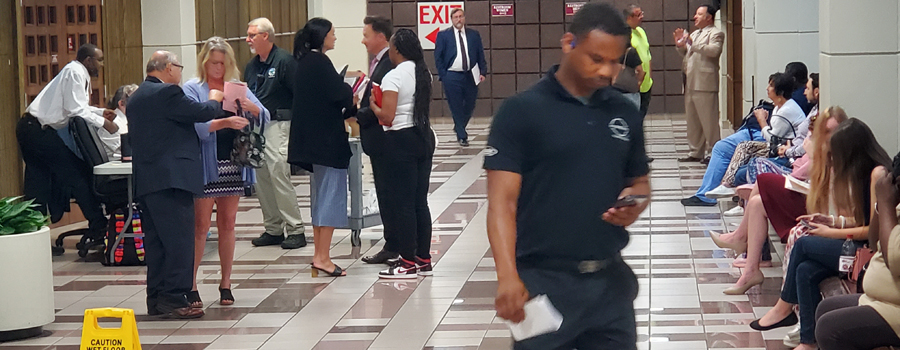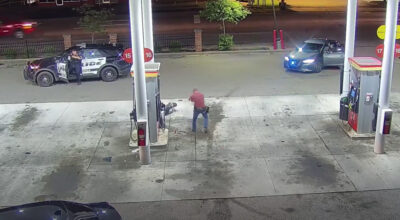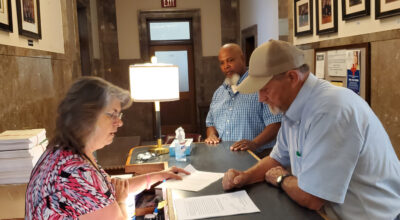
Two grand juries meet In the Hamilton County courts building in Chattanooga. (Photo David Tulis).
CHATTANOOGA, Tenn., Friday, Sept. 1, 2023 — “Waiving the court” and “sending the case to the grand jury” are real options in traffic cases, suggests a report issued by a grand jury in Hamilton County, Tenn.
By David Tulis / NoogaRadio Network
People charged under multiply abusive “traffic enforcement” customs in the Chattanooga area are assured their cases may not come up for review or be “no billed” by the group of citizens charged with sniffing out crimes public and private.
When pitted against manslaughter and other serious cases, your “traffic stop” comes in at the end of the list of deserving cases presented by cops, deputies and reps from DA Coty Wamp’s office.
We heard details of many different crimes, including first-degree premeditated murder, second degree murder, voluntary manslaughter, reckless endangerment, rape, child rape, child abuse, aggravated assault, theft, breaking and entering, domestic assault, fraud, false reports to police, criminal simulation, identity theft, and many variations of unlawful drug manufacture and sales (some resulting in death or serious injuries, some with children involved or present), driving under the influence, neighborhood and random shootings, and even some more serious traffic violations. [emphasis added]
A winning option as defendant is to send your criminal case to the grand jury that will weigh “more serious traffic violations” and jettison the rest. It would be to yield the right to have your case heard in sessions court and to insist on the greater right for an indictment issued by a grand jury.
Only “more serious” such cases will be heard, or get a “true bill,” in this one of two grand juries in Hamilton County. When the grand jury rejects police proposals for a criminal trial, it issues a “no bill” in the matter, and the alleged criminal case is vaporized, open to moves by you for expungement.
Among the myriad less serious cases are those against such people as Lamar Antrell Davenport who is “driving on revoked” and using the public road without proof of financial responsibility.
The CGJ, or concurrent grand jury, says in a report published at Chattanoogan.com that it heard 192 cases and returned 162 true bills or indictments, and 31 “no bills” clearing out the cases. Viewed another way, of the 192 cases heard, there were 558 charges on which it returned 472 true bills and 86 no bills. It also exercised the function of presentment. It weighed 44 presentments and return 43 true bills and one no bill. “The 44 presentments contained 116 separate charges, and we returned 115 true bills and one no bill.”
The jurors reject the accusation they are a “rubber stamp” for police. Under law they have power to investigate public oppression, fraud, misfeasance, malfeasance and misconduct. Their reports, however, indicate members generally are kept too busy with private crime to fulill their investigative duty to halt public corruption.
Grand juries are sometimes criticized for “rubber stamping” cases and always indicting. This criticism is neither accurate nor valid. But it is accurate that when a case is presented to the CGJ, the officers have generally already spent countless hours on arrests, follow-up investigations, paperwork and reports to the District Attorney’s office and the courts. The crimes and charges then presented to the CGJ are not frivolous. *** So it is true that most cases are true billed. This CGJ makes no apology for that because the cases it hears have been well investigated and considered by law enforcement and the DA’s office before they are heard by us. [Emphasis added]
A parallel grand jury, however, says it issued true bills in 99 percent of cases.
The grand jury insists on its members’ independence from the law enforcement machinery whose employees are ever present at the scenes of its courthouse work.
DA Wamp, ADA Tom Landis, or another ADA are present for all cases presented to the CGJ. They assist in answering any legal or process questions the jurors have but are not present when we vote to true bill or no bill a case or a charge. No persons other than the grand jurors and the foreman are present for consideration, discussions, and voting on each case. [Emphasis added]
The grand jury admits to further loss of esteem police, deputy jobs, an occupation responsible for 1,200 killings a y ear and untold beatings, tasings and injuries across the U.S. The report sees an “obvious shortage of officers” that is easing “somewhat.”
“[E]verything should be done to make law enforcement jobs viable – emphasizing better pay, excellent training, and exploring every way to win the support of the citizenry for law enforcement.”
David, Christopher Sapp look at the grand jury
The entire report smacks of “boot licking and holster sniffing,” says Christopher Sapp midstate bureau chief. “The Concurrent Grand Jury report is a puff piece for the police state. It is almost worshipful of the judiciary and prosecutorial machinery. It repeatedly trumpets the need for greater resources and monetary allocation in pursuit of expansion.
DA Wamp, assistant DA Tom Landis or another ADA are “present for all cases presented to the CGJ. They assist in answering any legal or process questions the jurors” but grand jurors deliberate in private.
Another point in your favor in challenging a traffic case: The grand jury and the concurrent grand jury are backlogged from the CV-19 overthrow.

